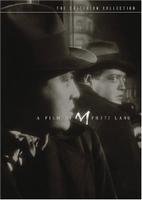
German expressionism, rising from the ashes of the recently lost WWI, this style of filmmaking is filled with dark, mysterious images that generally include horror, death, and violence. From these key points, it is easy to see why many German expressionist films were monster movies, such as Nosferatu, eine Symphonie des Grauens (1922). Even when many directors fled Germany because of WWII, German expressionism surfaced in America with Universal's famous 'Monster Movies'. One of the most famous films of this time period, Fritz Lang's M, is a masterpiece that grips the viewer with fear and suspense, even over 70 years after its creation. Lang's ability to use the right amounts of light and sound cause an amazing moving picture to emerge. Playing with the minds of both the characters of the film and the people of the audience, M is a film that is viewed by many to be the most psychological thriller of all time.
Although M may not have the digital quality or CGI special effects of today, it certainly makes up for it with the excellent storyline, the amazing Mise-en-Scene, and the spectacular acting. M is the story of Hans Beckert (Peter Lorre), a psychotic child murderer, whose current score is 8. Fortunately for us, the police are working 'hard' to find this evil man. However, after discovering he is not hiding in the local restaurant, in the station, or any other place that the police enjoy hanging out, everyone becomes frustrated. The criminals (yes, criminals) are frustrated too; with police raids every day, this child murderer becomes bad for 'business'. Schränker (Gustaf Gründgens), the head of the criminal union, organizes a joint collaboration between them and the beggar union to find this child murder.
Compared to the stories of today, this film does not seem to exceed. In addition to that, the poor quality of sound and picture do not appeal to many. How is this film such a big hit then? It is Fritz Lang's amazing ability to display the right amount of imagery and sound. M is considered by many to be the first 'talking picture' success. Why is this? Most of it has to do with Lang's distrust with the sound. He refused to have sound in this film, but obviously and ultimately lost. (One might say in retaliation) Lang has almost no sound in M, which gives it the suspense it needs. It is said that whenever there is a lack of non-diegetic sound for more then a minute and a half, the audience begins to feel awkward and nervous. This becomes very helpful in M. Especially in the final chase scene, the lack of sound creates an atmosphere that feels as if there is no one there, as if help will never arrive. The lack of sound also causes the viewer to concentrate on the screen more then the sound. This also becomes effective in the film, as shown during important times such as the court scene.
M is also famous for the many psychological views that are brought up. For instance, when trying to capture Beckert, the police are worthless while the criminals are organized and skilful. Even the different justice system they show could be viewed with much shock. The 'correct' version of justice that the police advertise would have Beckert eventually released back into the public with little to no punishment. However, the criminals wish to give Beckert a taste of his own medicine, or an eye for an eye. As Schränker says to Beckert, "You talk of rights? You will get your rights." Although the reader of this review may believe that the official rules of justice to be correct, Lang shows the criminal side to be . . . better. The criminal side of the law is more sympathetic with that of the victims. Since Beckert could never feel the pain of a Mother's sorrow, the criminals would like to show Beckert how it felt to be on the opposite side of the knife. The other hand of the law, however, believes that "No one can kill a man that isn't responsible for his actions" as Beckert himself said that these impulses to kill are involuntary.
This leads to another theme Lang shows us in his film. Beckert, who fights "this evil thing inside of me, the fire, the voices, the torment!" eventually looses (8 times) as the murderer takes control. The murder is quite fond for the song "In the Hall of the Mountain King", and it becomes an audio metonymy for the impulse of killing children. In a wonderful scene, Beckert is trying his best to drown out the sounds of his own whistling, the sounds of "In the Hall of the Mountain King". Failing (again) to defeat the evil inside, Beckert continues to stalk a little child, who trusts him enough to give him a knife. Why trust a stranger when there is a murderer on the loose? Because of Lang's ability to show the face of a murderer to be . . . normal. In the time period that M is filmed, many believed that the face showed the characteristics of the mind. Beckert looks as normal as any other man on the street, continuing the fear that a murderer can be anyone.
Based on the real life murderer, Peter Kürten (the vampire of Düsseldorf), M is an amazing film that explores the vast topic of psychology. This review has just touched the many, many themes that Lang shows in his masterpiece film. Although it is in black and white, the sound and visual quality of the film is poor, and the language is German (necessity of subtitles), M is a film that should be seen by all. For its wonderful Mise-en-Scene, or the excellent story, M will be enjoyed by anyone who wishes to view it.

